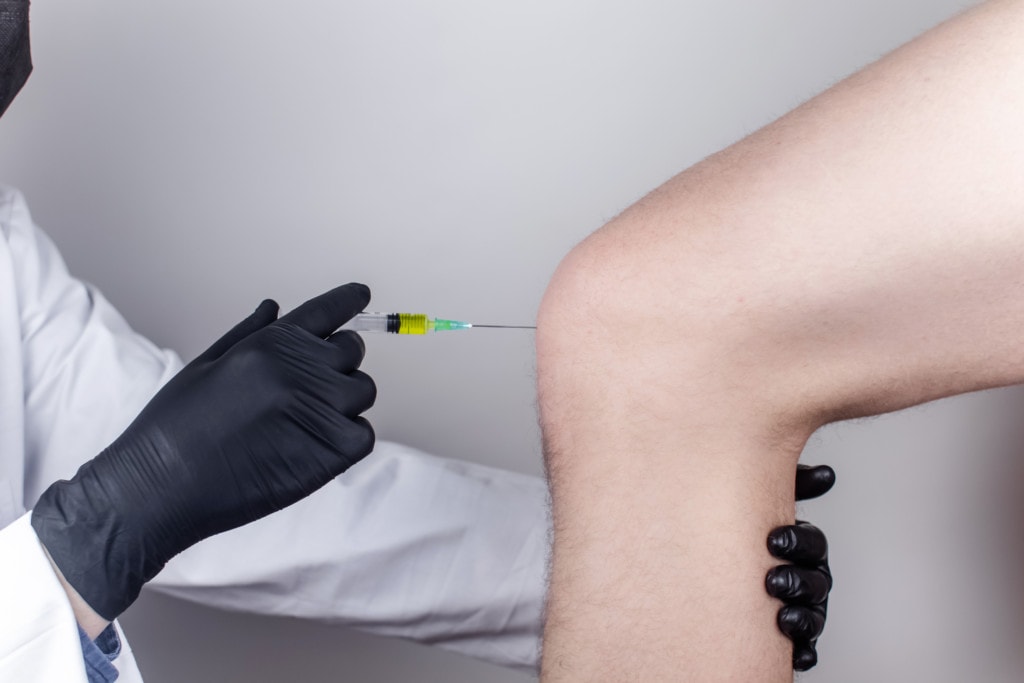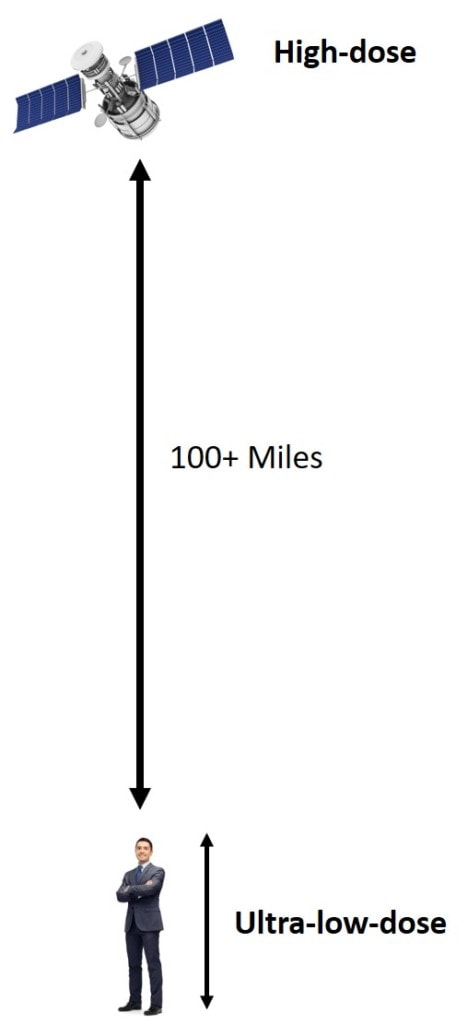Physiologic Dose Anti-inflammatory Injections

Credit: Shutterstock
Steroid anti-inflammatory injections can cause tissue damage. Why? Given that the body uses steroids to control inflammation, how could an injection of steroids be bad? Let’s dig in.
Anti-inflammatories and the Body
Corticosteroids are substances that reduce inflammation. The body uses a corticosteroid called hydrocortisone (Cortisol) at very low levels. How low? 60-230 nanograms per ml. Note that this is NANOgrams and NOT MILLIgrams.
Corticosteroids are also commonly used to treat swelling and inflammation by doctors. How does the level the body uses compare to the amount that we doctors inject? Doctors inject MILLIgrams or about 100,000 to 1,000,000 times more! Why? There is no medical or scientific rationale, this is just tradition.

So what does that dose difference look like? If the height of the average person represents the ultra-low dose your body should use, the high-dose commonly injected by doctors is represented by the height of a satellite in low earth orbit! How’s that for a ridiculous difference?
What Happens When You Inject this Much?
So what happens when you inject 100,000 times too much corticosteroid? Bad things. Before I get into this, realize that there is nothing wrong with corticosteroids as your body uses them safely all day every day. The problem here is the dose.
We’ve known for quite a while that steroid shots destroy cartilage. In fact, the first paper on this topic was in 1951! (4) That was followed by others in the 1960s and then a number of animal studies showing that steroid shots damage cartilage cells in joints, (5,6) If there was any doubt left, recently a randomized controlled trial in real patients demonstrated that patients who got steroid shots for knee arthritis had an accelerated loss of cartilage (1).
While the local impacts of steroid shots are very real and disturbing, there are also impacts on the body as a whole. Why? The steroids injected into joints and other areas are at a high enough dose that they can leach into many parts of the body. Hence, side effects can include abnormal bone repair, a whacked-out endocrine system, and loss of blood sugar control.
For example, one recent study demonstrated that the steroids used in epidural injections for sciatica worsened osteoporosis in women (2). The same steroid shots also interfere with the cortisol endocrine system that maintains health (3). Finally, getting your knee joint injected with these very high doses also interferes with your blood sugar, causing it to increase (7).
Can You Fix this Problem?
YES! Just mimic what the body does! Meaning, drop the dose 100,000 times. The problem? Steroids don’t come in these doses, so this needs to be custom compounded.
We’ve been using nanogram dose physiologic steroid injections for almost two decades now. Based on my experience and that of other physicians in the Regenexx network, these ultra-low-dose injections work without the crazy side effects of traditional high-dose steroid shots.
Hence, when a Regenexx network physician recommends an ultra-low-dose steroid injection this is COMPLETELY DIFFERENT than the high-dose of steroid that your orthopedic surgeon or pain management physician would use.
The upshot? When we use steroid shots at Regenexx, like everything else we do, it’s VERY DIFFERENT! So when your doctor recommends an ultra-low dose injection, that’s about as close to natural medicine as it gets.
__________________________________
References:
(1) McAlindon TE, LaValley MP, Harvey WF, et al. Effect of Intra-articular Triamcinolone vs Saline on Knee Cartilage Volume and Pain in Patients With Knee Osteoarthritis: A Randomized Clinical Trial. JAMA.2017;317(19):1967–1975. doi: 10.1001/jama.2017.5283
(2) Kang SS, Hwang BM, Son H, Cheong IY, Lee SJ, Chung TY. Changes in bone mineral density in postmenopausal women treated with epidural steroid injections for lower back pain. Pain Physician. 2012 May-Jun;15(3):229-36.
(3) Chon JY, Moon HS. Salivary cortisol concentration changes after epidural steroid injection. Pain Physician. 2012 Nov-Dec;15(6):461-6.
(4) STEINBROCKER O, EHRLICH ME, SILVER M, SICHER W, BERKOWITZ S, CARP S, FEISTEIN H. The clinical application of cortisone and ACTH in arthritis and related conditions: methods and problems. II: Side effects complications, contraindications, precautions and conclusions. Ariz Med. 1951 Sep;8(9):29-35.
(5) Wang BL, Sun W, Shi ZC, et al. Decreased proliferation of mesenchymal stem cells in corticosteroid-induced osteonecrosis of femoral head. Orthopedics. 2008;31(5):444. doi:10.3928/01477447-20080501-33
(6) Murray RC, DeBowes RM, Gaughan EM, Zhu CF, Athanasiou KA. The effects of intra-articular methylprednisolone and exercise on the mechanical properties of articular cartilage in the horse. Osteoarthritis Cartilage. 1998;6(2):106‐114. doi:10.1053/joca.1997.0100
(7) Habib GS. Systemic effects of intra-articular corticosteroids. Clin Rheumatol. 2009;28(7):749‐756. doi:10.1007/s10067-009-1135-x

If you have questions or comments about this blog post, please email us at [email protected]
NOTE: This blog post provides general information to help the reader better understand regenerative medicine, musculoskeletal health, and related subjects. All content provided in this blog, website, or any linked materials, including text, graphics, images, patient profiles, outcomes, and information, are not intended and should not be considered or used as a substitute for medical advice, diagnosis, or treatment. Please always consult with a professional and certified healthcare provider to discuss if a treatment is right for you.